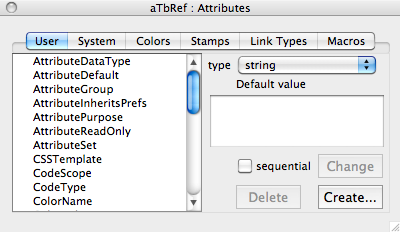
This allows the user to create, amend and delete custom attributes. The left pane lists any user attributes for the current Tinderbox document (file); note these custom additions are per-document only.
If an attribute is selected, the type pop-up shows the data type set for that attribute.
If an attribute is selected, the Default value box shows the default value, if any.
The sequential tick-box should only be used when creating new number-type attributes (from v5.8.0 is it only enabled when the current data type is Number). It causes the field to be incrementally numbering for each new note added. Existing notes will have a default value of 0, with the first note after creation of a sequential attribute having a value of 1, and so on. When duplicating a note, Tinderbox checks and updates all sequential attributes. Previously, the duplicate note copied all its attribute values without change.
Create button. This opens the Create Attribute dialog.
Delete button. This deletes the selected attribute - without any further warning. Use with care!
Change button. This is designed to allow you to change the default value for all subsequently created notes. It will allow you to change the attribute name and/or the data type - but don't - it can have undesired side effects. You are better off making a new attribute.
Individual attributes can be dragged out onto anywhere in a note's text window to add to existing $KeyAttributes.
Individual user attributes may be dragged from the user attributes pane of one document to another. To do this you must open the attributes dialog for both documents and select the User pane then drag the desired attribute from source to target. Dragging attributes between other windows/locations fails.